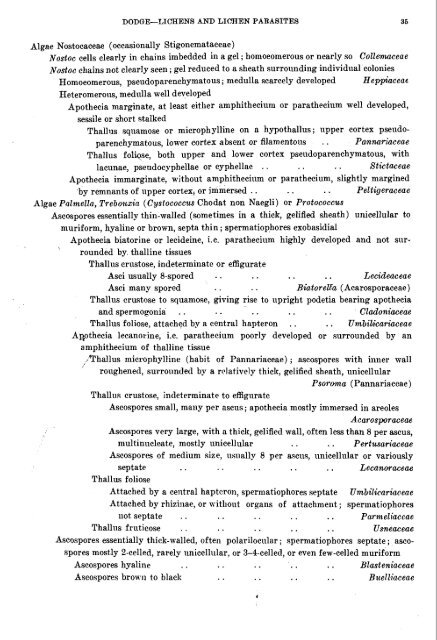You also want an ePaper? Increase the reach of your titles
YUMPU automatically turns print PDFs into web optimized ePapers that Google loves.
DODGE-<strong><strong>LICHEN</strong>S</strong> <strong>AND</strong> <strong>LICHEN</strong> <strong>PARASITES</strong> 35<br />
Algae Nostocaceae (occasionally Stigonemataceae)<br />
Nostoc cells clearly in chains imbedded in a gel ; homoeomerous or nearly so Collenlaceae<br />
Nostoc chains not clearly seen ; gel reduced to a sheath surrounding individual colonies<br />
Homoeomerous, pseudoparenchymat~~~ ; medulla scarcely developed Heppiaceae<br />
IIcteromerous, medulla well developed<br />
Apothecia marginate, at least either amphithecinm or parathecium well developecl,<br />
sessile or short stalked<br />
Thall~ls sqnamose or microphylline on a hypothallus; npper cortex psendoparenchymatous,<br />
lower cortex absent or filamentous . . Pannariaceae<br />
Thallus folkse, both upper and lower cortex pseudoparenchymatous, with<br />
lacunae, psendocyphellae or cyphellae . . . . . . Stictaceae<br />
Apothecia immarginate, without amphithecinm or parathecium, slightly margined<br />
by remnants of upper cortex, or immersed . . . . . . Peltigeraceas<br />
Algae Palmella, Trebowxia (Cystococc~cs Chodat non Naegli) or Protococcus<br />
Ascospores essentially thin-walled (sometimes in a thick, gelified sheath) unicellular to<br />
muriform, hyaline or brown, septa thin ; spermatiophores exobasidial<br />
Apothecia biatorine or lecideine, i.e. parathecinm highly developed and not snrrounded<br />
by thalline tissues<br />
Thallns crnstose, indeterminate or effigurate<br />
Asci usually %spored . . . . . . . . Lecideaceae<br />
Asci many spored . . . . Ria tor ella (Acarosporaceae )<br />
Thallus crustose to squamose, giving rise to npright podetia bearing apothecia<br />
and spermogonia . . . . . . . . . . Cladoniaceae<br />
Thallus foliose, attachqd by a central hapteron . . . . UrnbiLicariaceae<br />
A~othecia lecanorine, i.e. parathecium poorly developed or surrounded by an<br />
amphithecium of thalline tissue<br />
.?l!hallus microphylline (habit of Pannariaceae) ; ascospores with inner wall<br />
roughened, surrounded by a relatively thiclr, gelified sheath, unicellular<br />
Pso?.oma (Pannariaceae)<br />
Thallus crustose, incleterminate to effignrate<br />
Ascospores small, many per ascns; apothecia mostly immersed in areoles<br />
Acarospraceae<br />
Ascospores very large, with a thiclr, gelified wall, often less than 8 per ascus,<br />
multinucleate, mostly nnicellular . . . . Pertzuariaceae<br />
Ascospores of medium size, usually 8 per awns, nnicellnlar or variously<br />
septate . . . . . . . . . . Lecanmaceae<br />
Thallus foliose<br />
Attached by a central haptcron, spermatiophores septate Umbilicariaceae<br />
Attached by rhizinae, or without organs of attachment ; sper~natiophores<br />
iiot septate . . . . . . . . . . Purmeliaccae<br />
Thallus frnticose . . . . . . . . . . Usneaceae<br />
Ascospores essentially thick-walled, often polarilocnlar ; spermatiophores septate ; ascospores<br />
mostly 2-celled, rarely unicellular, or 3-4-celled, or even few-celled muriform<br />
Ascospores hyaline . . . . . . . . . . Blasteniaceae<br />
Ascospores brow11 to black . . . . . . . . Bzcelliaceae

















